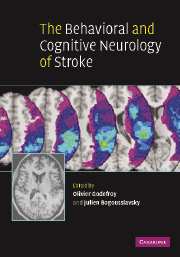Book contents
- Frontmatter
- Contents
- Contributors
- Preface
- 1 Evaluation of cognitive and behavioral disorders in the stroke unit
- Motor and gestural disorders
- Aphasia and arthric disorders
- 4 Aphasia in stroke
- 5 Acute vascular aphasia
- 6 Dysarthria
- 7 Alexia and agraphia in acute and chronic stroke
- 8 Acalculia and Gerstmann's syndrome
- Hemineglect, Anton–Babinski and right hemisphere syndromes
- Agnosia and Bálint's syndrome
- Executive and memory disorders
- Behavioral and mood disorders
- Dementia and anatomical left/right syndromes
- Index
- References
8 - Acalculia and Gerstmann's syndrome
Published online by Cambridge University Press: 10 October 2009
- Frontmatter
- Contents
- Contributors
- Preface
- 1 Evaluation of cognitive and behavioral disorders in the stroke unit
- Motor and gestural disorders
- Aphasia and arthric disorders
- 4 Aphasia in stroke
- 5 Acute vascular aphasia
- 6 Dysarthria
- 7 Alexia and agraphia in acute and chronic stroke
- 8 Acalculia and Gerstmann's syndrome
- Hemineglect, Anton–Babinski and right hemisphere syndromes
- Agnosia and Bálint's syndrome
- Executive and memory disorders
- Behavioral and mood disorders
- Dementia and anatomical left/right syndromes
- Index
- References
Summary
Introduction
Neurologists' knowledge of number processing impairments is often limited to the notion that acalculia is part of Gerstmann's syndrome (Benton, 1992; Gerstmann, 1940). It may extend to the classical typology proposed by Hécaen, who distinguished aphasic, spatial, and anarithmetic acalculia (Hécaen et al., 1961). Actually, modern research on acalculia (a term coined by Henschen, 1920) has made considerable progress from this point, starting in the 1980s within the expanding framework of cognitive neuropsychology, and soon yielding refined cognitive models (Dehaene, 1992; Deloche and Seron, 1982; McCloskey et al., 1986). Presently, it is an important component of the cognitive neuroscience of numerical abilities, having close links to the methodology used in and theories arising from numerical cognition studies performed in animals, human infants, or normal adults. These methodologies include behavioral measures, functional and anatomical imaging, and electrophysiological techniques (for reviews see Butterworth, 1999; Dehaene and Cohen, 1995; Dehaene et al., 2004).
Beyond its fundamental interest, acalculia constitutes a frequent and incapacitating disorder following acquired, mostly left-hemispheric, brain lesions (Jackson and Warrington, 1986; Rosselli and Ardila, 1989). It interferes with many everyday life activities such as shopping, assessing the balance of a bank account, etc.
In this chapter we will summarize the basic facets of the normal number processing abilities, sketch a simple model of their anatomical implementation, describe an illustrative variety of calculation disorders, briefly discuss the relationships of acalculia, Gerstmann's syndrome and the parietal lobes, and finally propose some guidelines for the assessment and rehabilitation of acalculia in stroke patients.
- Type
- Chapter
- Information
- The Behavioral and Cognitive Neurology of Stroke , pp. 126 - 147Publisher: Cambridge University PressPrint publication year: 2007
References
- 3
- Cited by



